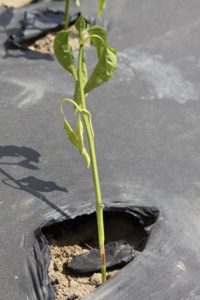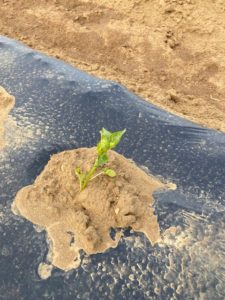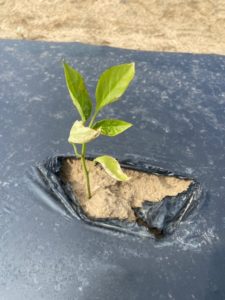There are a couple of additional reasons you might consider placing soil around the transplant hole when using plastic mulches, but take note – this practice should come with a significant warning label!

This pepper seedling is wilting because the stem is severely burned where it touched the hot plastic mulch.
In addition to reducing heat venting and water pooling that Michelle described in her previous post, one of the first reasons this practice gained popularity among vegetable growers was to prevent the plastic mulch burns on the stems of transplants, especially tomatoes and peppers. On bright sunny days during the transplanting season from late April through June, the temperature of unshaded, black plastic mulch will get hot enough to cause a burn on the stem if touching the transplant. Coupled with wind whipping and rapid transpiration, stem burn can kill a new transplant outright. If the plant does survive, there can be enough damage that later in the season the stem is too weak to support the top growth and the plant topples over.
For that reason, the current Mid-Atlantic Commercial Vegetable Production Recommendations, especially for peppers, is to, “Use opaque, white plastic when planting in the summer [and even late spring] for fall harvest.”
Warning – consider these factors in selecting soil to put around transplants on plastic mulch:
Many growers have learned in the school of hard knocks that this practice can cause some problems as serious as those they were trying to prevent. By trial and error, most have learned that the best soil to put around transplant holes is clean, washed sand from a site other than the field where it is applied, or field soil that has been fumigated the same as the mulched beds.
Why?
- If you fumigate or apply fungicides to the beds to prevent Phytophthora, nematodes and other soil born diseases, putting untreated soil from between the beds puts innoculum right at the base of the susceptible new transplant, defeating the purpose of the fumigation, and maybe making the situation worse because there are no competing beneficial organisms to slow the development of those pathogens.
- Untreated soil from between beds will also contain weed seeds that won’t be controlled by pre-plant herbicides applied under the plastic mulch.
- To make matters worse, even if the soil between the beds was fumigated, if an herbicide was applied before transplanting, concentrating those herbicides at the base of a transplant may not be labeled for that use and likely will be toxic to the transplant.
Dr. Thierry Besancon, Rutgers Extension Weed Specialist for Specialty Crops, identified many herbicides labeled for use on bare soil between plastic beds that he would consider potentially dangerous to the transplants if soil containing these compounds would be added above the planting hole:
- Fomesafen (Reflex): labeled PRE for row middles and under plastic on some crops. Unfortunately, it has also POST activity..
- Pendimethalin (Prowl): labeled ONLY for row middle applications in plasticulture
- Trifluralin (Treflan): labeled ONLY for row middle applications in plasticulture
- Halosulfuron (Sandea): labeled for row middles only. Has both PRE and POST activity which could result in severe crop injury if the herbicide get in contact with the crop.
- Clomazone (Command, Strategy): even if it’s labeled for under plastic and row middles PRE application in some crops, be extremely careful with this herbicide that cannot be applied over emerged plants.
- Metribuzin: only labeled for row middles application in plasticulture – potential risk of injury if soil containing it is used around the hole because it has POST activity
- Rimsulfuron (Matrix): labeled only for row middles with both PRE and POST activity on broadleaf species.
- Terbacil (Sinbar): used PRE under plastic or in row middles, but has POST activity and should never be applied over the crop.
- Ethalfluralin (Curbit): labeled ONLY for row middle applications in plasticulture
Other PRE herbicides such as bensulide (Prefar), napropamide (Devrinol) or s-metolachlor (Dual Magnum) should not cause damage but using soil that has been treated with these products when adding soil around the transplant holes is discouraged as no tests have ever been conducted to make sure this is really safe, essentially because these herbicides are not supposed to be used this way.
Dr. Besancon says, “Actually, the only herbicides I would really feel confident about are the graminicides (Poast, Select) and paraquat: graminicides are only targeting grasses and paraquat will tied up to Organic Matter particles (virtually inactive in the soil).
He also warns that this technique, if using soil from between the mulched beds, disturbs the uniform herbicide distribution in the row middles by creating gaps in the coverage… herbicide-free spaces where weeds will grow! Not disturbing the soil is essential for maintaining the efficacy of PRE herbicides.
Placing soil around the base of new transplants on plastic mulch can protect tender plants from being damaged by heat, water and the plastic itself, saving time and money by reducing the need to replace plants later. Using the right soil for the job will make sure you don’t lose those savings by creating new problems!

 base of the plant and enough to seal the hole around the plant. This works best for transplants with tall stems – tomatoes, peppers, eggplants and cole crops.
base of the plant and enough to seal the hole around the plant. This works best for transplants with tall stems – tomatoes, peppers, eggplants and cole crops. and tied.
and tied.